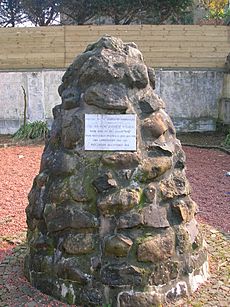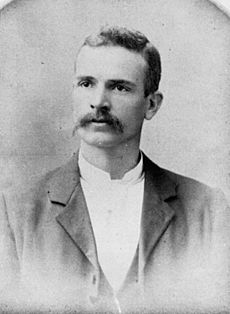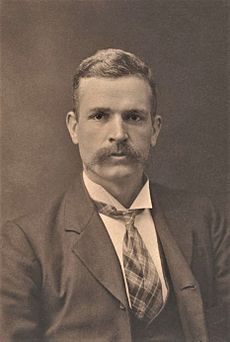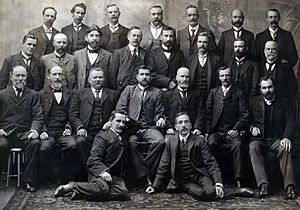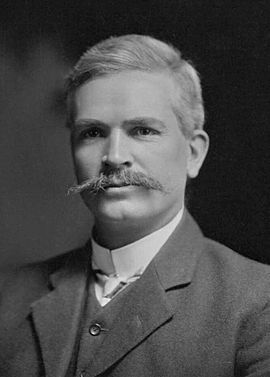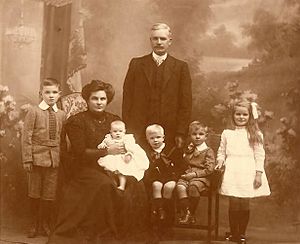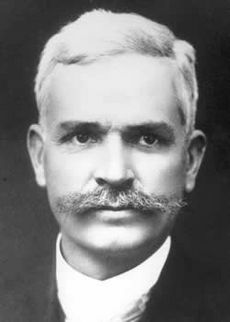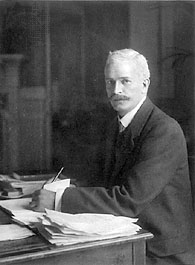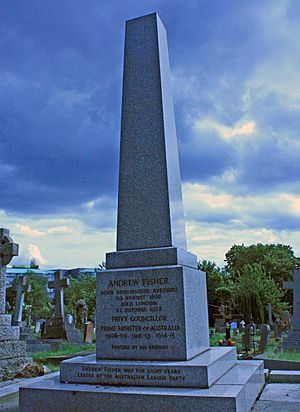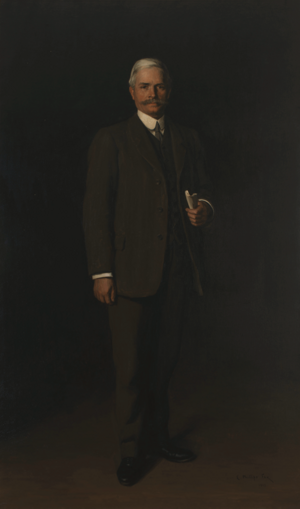Andrew Fisher facts for kids
Quick facts for kids
Andrew Fisher
|
|
|---|---|
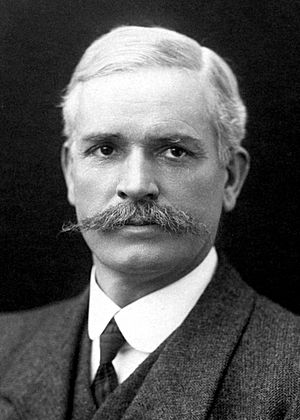
Fisher in 1912
|
|
| 5th Prime Minister of Australia | |
| In office 13 November 1908 – 2 June 1909 |
|
| Monarch | Edward VII |
| Governor-General | Lord Dudley |
| Preceded by | Alfred Deakin |
| Succeeded by | Alfred Deakin |
| In office 29 April 1910 – 24 June 1913 |
|
| Monarch | Edward VII George V |
| Governor-General | Lord Dudley Lord Denman |
| Preceded by | Alfred Deakin |
| Succeeded by | Joseph Cook |
| In office 17 September 1914 – 27 October 1915 |
|
| Monarch | George V |
| Governor-General | Sir Ronald Munro Ferguson |
| Preceded by | Joseph Cook |
| Succeeded by | Billy Hughes |
| 5th Leader of the Opposition | |
| In office 2 June 1909 – 29 April 1910 |
|
| Prime Minister | Alfred Deakin |
| Preceded by | Alfred Deakin |
| Succeeded by | Alfred Deakin |
| In office 8 July 1913 – 17 September 1914 |
|
| Prime Minister | Joseph Cook |
| Preceded by | Joseph Cook |
| Succeeded by | Joseph Cook |
| 2nd Leader of the Labor Party | |
| In office 30 October 1907 – 27 October 1915 |
|
| Deputy | Gregor McGregor Billy Hughes |
| Preceded by | Chris Watson |
| Succeeded by | Billy Hughes |
| High Commissioner to the United Kingdom | |
| In office 1 January 1916 – 22 April 1921 |
|
| Preceded by | Sir George Reid |
| Succeeded by | Joseph Cook |
| Member of the Australian Parliament for Wide Bay | |
| In office 30 March 1901 – 26 October 1915 |
|
| Preceded by | Seat created |
| Succeeded by | Edward Corser |
| Member of the Queensland Legislative Assembly for Gympie | |
| In office 25 March 1899 – 9 May 1901 Serving with George Ryland
|
|
| Preceded by | Jacob Stumm |
| Succeeded by | Daniel Mulcahy |
| In office 25 May 1893 – 11 April 1896 Serving with William Smyth
|
|
| Preceded by | Matthew Mellor |
| Succeeded by | Jacob Stumm |
| Personal details | |
| Born | 29 August 1862 Crosshouse, Ayrshire, Scotland |
| Died | 22 October 1928 (aged 66) Hampstead, London, England |
| Resting place | Hampstead Cemetery |
| Political party | Labor |
| Spouses |
Margaret Irvine
(m. 1901) |
| Children | 6 |
| Occupation | Miner, trade union official |
Andrew Fisher (born 29 August 1862, died 22 October 1928) was an important Australian politician. He served as the Prime Minister of Australia three times. His terms were from 1908 to 1909, 1910 to 1913, and 1914 to 1915. He also led the Australian Labor Party (ALP) from 1907 to 1915.
Fisher was born in Scotland and started working in coal mines at a young age. He became involved in trade unions, which are groups that protect workers' rights. In 1885, he moved to Australia and continued his work with unions. He became a politician in Queensland and later in the new federal parliament. Fisher's time as Prime Minister brought many important changes to Australia.
Contents
Andrew Fisher's Early Life
Growing Up in Scotland
Andrew Fisher was born on 29 August 1862 in a mining village called Crosshouse in Scotland. He was the second of eight children. His family had a long history of working in coal mines. His father was involved in community groups and a local cooperative, which is a business owned and run by its members.
As a child, Fisher lived in a simple home with an earthen floor. He was partly deaf in one ear due to an accident. He enjoyed fishing and walking in the countryside. He was also good at sports and helped start a local football team. Fisher went to school for a few years, which was common at the time. He also studied at night school and read books at the town library to learn more.
Starting Work in the Mines
Fisher started working in the coal mines when he was quite young, possibly around nine or thirteen. He began by opening and closing trapdoors for air and coal movement. Later, he worked with the pit ponies and then did the hard "pick-and-shovel work" at the coalface. When he was 16, he got a more advanced job operating air-pumps.
His father had a lung disease from mining and stopped working in the mines. The family then moved and his father worked as a gardener. Andrew Fisher became involved in the Ayrshire Miners' Union at age 17. He met Keir Hardie, who later became a leader of the British Labour Party. Fisher was part of a miners' strike in 1881. After another strike, he lost his job and couldn't find work in Scotland. This led him to decide to move to Australia.
Moving to Australia
Andrew Fisher arrived in Brisbane, Queensland, Australia, on 17 August 1885. He had traveled by steamship from London for two months. He first worked in the Burrum River coalfields, where many Scottish miners lived. He joined the local miners' union.
Fisher later moved to Gympie, a gold-mining town, in 1888. He continued to be active in unions there, helping to form the Gympie branch of the Amalgamated Miners' Association. He became the president of this group. He also got a certificate to operate engine machinery above ground in the mines. In Gympie, he lived in a boardinghouse and later married his landlady's daughter, Margaret Irvine.
Fisher quickly became an important figure in the Gympie labor movement. He helped start a local cooperative and became secretary of the Gympie Joint Labour Committee. He was also a founding member and first president of the local branch of the Workers' Political Association, which was the early Labor Party.
Early Political Career
Queensland Parliament
In 1893, Fisher was elected to the Legislative Assembly of Queensland as a Labor member for Electoral district of Gympie. He quickly became the deputy leader for Labor in the Assembly. In his first speech, he supported reducing military spending and creating a federation of the Australian colonies. He also strongly opposed the use of workers from the Pacific Islands on sugar plantations.
He lost his seat in 1896 but returned to parliament in 1899. That same year, he briefly served as Secretary for Railways and Public Works in the government led by Anderson Dawson. This was the world's first parliamentary Labor government, though it only lasted seven days.
Joining Federal Politics
Andrew Fisher strongly believed in the Federation of Australia, which was about uniting the different Australian colonies into one country. He campaigned for the 'Yes' vote in Queensland's 1899 referendum. In 1901, he was elected to the new federal parliament for the area of Division of Wide Bay. He held this seat throughout his federal political career.
In 1904, Fisher became the Minister for Trade and Customs for a few months. This was part of the short-lived government led by Chris Watson, who was Labor's first Prime Minister. Fisher showed he was a capable minister. In 1905, he was promoted to Deputy Leader of the Labor Party.
In 1907, Fisher became the leader of the Labor Party, taking over from Chris Watson. He was seen as someone who understood money matters well and could work effectively with the party. He was also known for being a radical, meaning he wanted big changes to help working-class people.
Andrew Fisher as Prime Minister
First Term (1908–1909)
In November 1908, Andrew Fisher became Prime Minister for the first time. His government was a "minority government," meaning it didn't have the most seats but had enough support to govern. During this term, his government passed laws to establish the new federal capital in the Yass-Canberra area. They also started building Australia's navy by ordering three destroyers.
Fisher's government also worked on plans to expand pensions for older people, introduce a land tax, and build a transcontinental railway. They also wanted to replace British money with Australian currency. However, in May 1909, two other parties joined together to form the Commonwealth Liberal Party. This new party had more seats, and their leader, Alfred Deakin, replaced Fisher as Prime Minister.
Second Term (1910–1913)
In the 1910 election, the Labor Party won a clear majority of seats in both houses of parliament. This was a big achievement, making Fisher's second government Australia's first elected federal majority government and the world's first Labor Party majority government.
This second term was a time of great reform. Fisher's government passed many new laws in just three years.
- They expanded old-age and disability pensions.
- They introduced a maternity allowance to help families with new babies.
- They issued Australia's first paper currency.
- They officially formed the Royal Australian Navy.
- They began building the Trans-Australian Railway.
- They founded the city of Canberra as the national capital.
- They established the state-owned Commonwealth Bank.

They also introduced a land tax to break up large land estates and help small farms. They improved conditions for workers at sea and made it easier for naturalized residents to get pensions. Fisher wanted the federal government to have more power over things like trade and monopolies. He held two referendums (public votes) in 1911 and 1913 to change the Constitution, but both were defeated. In the 1913 election, Labor narrowly lost to the Liberal Party, and Joseph Cook became Prime Minister.
Third Term (1914–1915)
Labor still controlled the Senate even after losing the 1913 election. In 1914, Prime Minister Joseph Cook called for a new election, which was Australia's first "double dissolution" election. This means both houses of parliament were dissolved. The First World War began during this election campaign. Both sides promised Australia would support the British Empire. Fisher famously declared that Australia would defend Britain "to the last man and the last shilling."
Labor won the election, and Fisher became Prime Minister for a third time on 17 September 1914.
Fisher's government immediately focused on organizing Australia's war effort. They passed laws to ensure national security and provide pensions for soldiers who were injured or died in the war. Fisher also received a report on the difficult situation for Australian troops in Gallipoli. This report helped lead to the decision to evacuate the troops.
Fisher resigned as Prime Minister on 27 October 1915. His deputy, Billy Hughes, then became the leader of the Labor Party and the new Prime Minister.
High Commissioner to the United Kingdom
From 1916 to 1921, Andrew Fisher served as Australia's High Commissioner to the United Kingdom. This role meant he was Australia's main representative in London. During this time, he disagreed with Billy Hughes about conscription (forcing people to join the army). Fisher refused to publicly support conscription.
He also served on the Dardanelles Commission, which investigated the Gallipoli campaign. The commission found that the campaign was poorly planned and executed.
Final Years and Death
Fisher's term as High Commissioner ended in 1921. He returned to Australia for a short time and considered returning to politics, but decided against it. He and his wife then moved back to London to be closer to their children.
As he got older, Fisher's family noticed a decline in his mental abilities. He passed away on 22 October 1928, at the age of 66, from complications of influenza. He was buried in Hampstead Cemetery in London. A memorial was later unveiled above his grave.
Evaluation of Andrew Fisher
For many years, Andrew Fisher and his governments didn't get as much attention from historians as some other prime ministers. However, more recently, people have started to appreciate his importance.
People who knew Fisher often described him as modest, honest, and dedicated to helping working people. He was praised for managing different personalities within his own party. Modern historians now see him as a very important figure in the early years of the Labor Party. They believe he helped establish Labor as a strong governing party and showed that the party could achieve its goals without giving up its principles.
Honours
Andrew Fisher received some honours during his life, but he often turned them down because he didn't like decorations. For example, he declined an award from France and honorary degrees from several universities.
However, he did accept an appointment to the Privy Council of the United Kingdom in 1911. This gave him the title "The Right Honourable" and meant he was part of important imperial discussions.
Several places in Australia are named after him:
- The federal voting area of Fisher in Queensland.
- A suburb in Canberra called Fisher, where the streets have mining-related names to honor his early career.
In 1972, Australia Post issued a postage stamp with his portrait. His former home in Gympie, known as "Andrew Fisher's Cottage", is now a heritage-listed site.
See Also
 In Spanish: Andrew Fisher para niños
In Spanish: Andrew Fisher para niños
Images for kids


